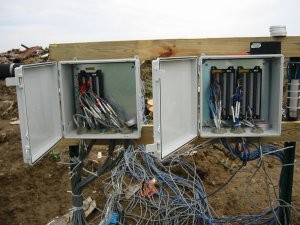| Principal Investigator: | Dr. Milind V. Khire, P.E. |
| Funding Agency: | Waste Management, Inc. |
Abstract
Leachate recirculation in municipal solid waste (MSW) landfills offers these key benefits: (1) reduction in leachate treatment and disposal costs; (2) accelerated decomposition and settlement of waste resulting in gain in airspace; (3) acceleration in gas production; and (4) potential reduction in post-closure care period and associated costs.
Most common methods for long-term leachate recirculation in MSW landfills include vertical injection wells and horizontal trenches. Both of these methods result in non-uniform distribution of leachate. In addition, the amount of leachate that can be recirculated by these methods is not sufficient to get rid off all leachate typically produced by landfills located in humid regions. Non-uniform distribution of leachate leads to uneven landfill settlement and hence higher maintenance costs.
The PI has developed a new design concept consisting of a horizontal blanket made up of relatively high hydraulic conductivity material(s) to recirculate leachate. Saturated/unsaturated leachate flow modeling conducted by the authors indicate that horizontal blankets made of relatively high hydraulic conductivity materials are capable of recirculating leachate at a rate up to an order greater than the conventional methods. In addition, the horizontal blanket is capable of achieving relatively uniform leachate distribution which is expected to reduce uneven settlement in a landfill. If the blanket is made up of recycled materials such as scrap tires, this design option can be cost-effective.
In this project, we are evaluating the field-scale performance of a test section of horizontal blanket made up of scrap tires. This test section was built at an active landfill located in Michigan. The aerial dimensions of the test section were 55m by 9m (180ft by 30ft). The test section consisted of the following components, from bottom to top:
a non-woven geotextile laid horizontally on the waste surface followed by
approximately 0.6m (2ft) thick shredded scrap tires followed by
a non-woven geotextile.
The uppermost geotextile was covered by MSW. A 9m (30 ft) long perforated HDPE pipe was installed at the center of the test section, parallel to the short side, for injecting leachate. Fifteen uniformly spaced moisture content sensors were installed at the bottom of the test section to detect the movement of injected leachate. A load sensor was installed to monitor the weight (or stress) of the waste placed on the test section. A digital pressure gauge and a magnetic flow meter were installed to monitor the leachate head and flow. All sensors including meteorological data sensors were connected to an on-site data logger programmed to take readings every minute or at an appropriate desired frequency. A relatively high flow pump was used to conduct leachate recirculation trials at leachate flows ranging from 15 to 140 gpm (3.4 to 32 m³/hr). The data collected from the sensors indicated that leachate traveled across the entire length of the test section through the tires (~30m). The amount of time required for leachate travel across the blanket varied from 10 minutes to over 90 minutes depending upon the leachate flow. The data collected from the field trial verified the numerical modeling results and proved that horizontal blankets made up of scrap tires are cost-effective and are hydraulically efficient for recirculation of leachate in MSW landfills.
Resulting Publications
Haydar, M., and Khire, M. (2004), “Field-Scale Testing of Leachate Recirculation Blanket Made Up of Scrap Tires at a MSW Landfill,” Proceedings of the Nineteenth International Conference on Solid Waste Technology and Management, Philadelphia, March 2004, accepted.
Haydar, M., and Khire, M. (2004), “Numerical Evaluation of Anisotropy and Heterogeneity of Waste Hydraulic Conductivity on Leachate Recirculation in MSW Landfills,” Proceedings of the Nineteenth International Conference on Solid Waste Technology and Management, Philadelphia, March 2004, accepted.
Haydar, M., and Khire, M. (2006). “Geotechnical Sensor System to Monitor Injected Liquids in Landfills” Geotechnical Testing Journal, American Society of Testing of Materials, Vol. 29, No. 1, 1-12.
Haydar, M., and Khire, M. (2005), “Leachate Recirculation Using Horizontal Trenches in Bioreactor Landfills” Journal of Geotechnical & Geoenvironmental Engineering, American Society of Civil Engineers, Vol. 131, No. 7, 837-847.
Haydar, M., and Khire, M. (2005), “Numerical Evaluation of Heterogeneity and Anisotrophy of Waste Properties on Leachate Recirculation in Bioreactor Landfills” The Journal of Solid Waste Management & Technology, Vol. 30, No. 4, 233-243.
Khire, M., and Haydar, M. (2004), “Leachate Recirculation in Bioreactor Landfills Using Geocomposite Drainage Material” Journal of Geotechnical & Geoenvironmental Engineering, American Society of Civil Engineers, in review.


